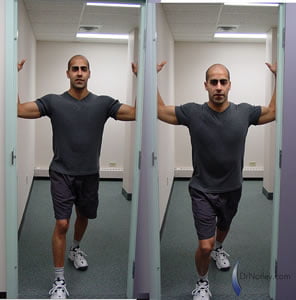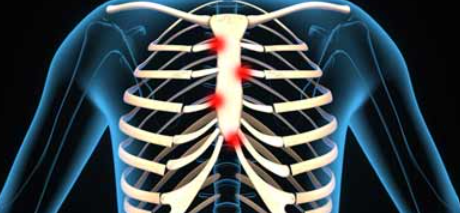Costochondritis: Symptoms, Causes, Treatment, Exercises
:format(webp)/cdn.mskdoctors.com/storage/2024/8/jQWG8wQkqwW8uvg2oI0Ky4veDkZHXO87.jpg)
Key Takeaways
-
Costochondritis is a condition where the cartilage that connects a rib to the breastbone becomes inflamed.
-
Typical symptoms include a sharp pain in the chest, which can become worse with movement or deep breaths.
-
The condition can be caused by a variety of factors, including physical strain and viral infections, but in many cases, the exact cause is not known.
-
Diagnosing costochondritis often involves ruling out other conditions, as there is no specific test for it.
-
Rest, pain management, and gentle exercises are common treatments for costochondritis, but in severe cases, physical therapy or medication may be necessary.
What Is Costochondritis?
Experiencing a sharp pain in your chest can be alarming, and it's easy to fear the worst. However, sometimes the cause is not a heart condition but a lesser-known condition called costochondritis. This is when the cartilage where the upper ribs connect to the breastbone, or sternum, becomes inflamed. This area is known as the costosternal junction.
Getting to Know Costochondritis
One's ribcage has the ability to expand and contract with every breath you take. This flexibility is possible because of cartilage. When this cartilage gets inflamed, each breath, cough, or even the slightest movement can cause a sharp or aching pain that can be very worrisome.
How Costochondritis Differs From Other Types of Chest Pain
Costochondritis is not like any chest pain associated with the heart. It is reproducible, meaning you can usually locate a specific spot that is more painful when pressed. It is also generally localized to one side of the chest and does not radiate to other areas.
Causes of Costochondritis
Causes of costochondritis include:
-
Heavy lifting or intense exercise that puts strain on the body
-
Excessive coughing, which puts strain on the chest
-
Chest injuries, such as those sustained in falls or car accidents
-
Underlying health problems, such as arthritis or infections in the joints
Symptoms of Costochondritis
The main symptom of costochondritis is pain in the chest. This pain can be sharp or dull, and it often gets worse when you take a deep breath, cough, or move in certain ways. The pain is usually on the left side of your breastbone, but it can affect both sides.
Costochondritis Symptoms Can Differ
The severity of symptoms can range from mild to severe and they can last anywhere from a few days to several weeks. Sometimes the pain can be constant, while other times it may come and go.
When to Seek Help Costochondritis
Recognizing Warning Signs and When to See a Doctor
Costochondritis is not fatal, but it's important to eliminate the possibility of more dangerous causes of chest pain. So, if you have ongoing or intense chest pain, it's vital to get medical help right away to make sure it's not something serious like a heart attack.
How is Costochondritis Diagnosed?
When your doctor examines you, they will probably press on the cartilage in your chest to see if it is tender. They may also have you move in certain ways to see if the pain increases, which could be a sign of costochondritis.
Your doctor might also ask for tests like an ECG or chest X-ray to eliminate the possibility of other conditions. If these tests return normal results and your physical exam aligns with costochondritis, then you'll likely be diagnosed with the condition.
Preparing for Costochondritis Check Up
Before you go to your appointment, write down your symptoms, when they happen, what makes them better or worse, and if you've had any recent injuries or illnesses. This will help your doctor figure out an in depth and thorough remedy.
Treatment for Costochondritis
The main focus of costochondritis treatment is to alleviate pain and lessen inflammation.
It is usually suggested to rest and steer clear of activities that may intensify the pain. Using heat or ice on the area that is affected may also help to control pain and inflammation.
Medications and Non-Drug Treatments
Over-the-counter painkillers such as ibuprofen or naproxen may be beneficial. In certain situations, your doctor may prescribe more potent medications. It is also important to follow the doctor's advice when taking any medication.
Adapting Your Lifestyle to Speed Up Healing
Adapting your lifestyle, such as limiting physical exertion, maintaining good posture, and managing stress, can also help you recover faster. The chief idea is to allow your body to heal while minimizing the chances of making the condition worse.
Exercises to Manage Costochondritis
Exercises, particularly ones that stretch and strengthen, can be a good way to manage costochondritis. They can help to relieve tightness and make the muscles in the chest wall stronger, which can help to lessen symptoms.
Easy Stretching Exercises to Alleviate Pain
Performing gentle stretches that expand the chest can help to reduce pain. For example:
-
Doorway stretches: Position yourself in an open doorway, put your hands on the door frame, and gently lean forward to stretch the chest muscles.
-
Corner stretches: Stand facing the corner of a room, extend your arms, and put your palms against the walls, then gently lean in until you feel a stretch.

It's crucial to do these stretches slowly and without pushing to the point of pain.
Using foam rollers is another helpful exercise. When you lie on a foam roller along your spine, it can help to open your chest and lessen tension in the area.
Deep breathing exercises are beneficial as they promote the full expansion of the ribcage and relaxation of the chest muscles.
For instance, a basic deep breathing exercise requires sitting or standing with proper posture, taking a deep breath through the nose, holding the breath for a few seconds, and then exhaling slowly through the mouth.
Strengthening Exercises to Avoid Recurrence
When the pain from costochondritis starts to lessen, strengthening exercises can help avoid recurrence. These exercises should concentrate on the muscles around the chest and upper back to offer better support to the ribcage.
Wall push-ups or light dumbbell presses can be helpful exercises, but they should be added slowly and done under the supervision of the healthcare provider to prevent making the condition worse.
Prognosis for Costochondritis
Most people with costochondritis see complete recovery, so the prognosis is typically positive. Yet, for some, the condition can be long-term, and dealing with symptoms can be an ongoing journey.
Long-Term Outlook for Costochondritis
Costochondritis typically resolves within a few weeks to a few months. The long-term focus is on promptly addressing any flare-ups and maintaining good chest health through exercise and proper ergonomics.
-
In the uncommon instances where costochondritis lingers, more aggressive treatments like physical therapy or even injections such as cortisone or lidocaine might be required.
-
A holistic approach that includes pain management, physical therapy exercises, and lifestyle changes can help manage chronic cases and reduce their impact on daily life.
-
Monitoring the boundaries of your body and learning to regulate your activities can assist in dealing with the long-term symptoms of costochondritis.
For example, someone who regularly suffers from bouts of pain may find it beneficial to change their workout regimen to include more low-impact exercises like swimming or biking, which put less stress on the chest region.
Advice for Coping with Costochondritis
While costochondritis can make day-to-day life difficult, there are strategies to handle it effectively:
-
Be aware of your posture, particularly if you spend a lot of time sitting at a desk.
-
Include breaks in your daily routine to stretch and move about.
-
Control stress, which can intensify pain, through relaxation methods such as meditation or yoga.
-
Exercise caution when lifting heavy items, and steer clear of activities that place too much pressure on your chest.
-
Maintain a log of your pain episodes, their severity, and any potential triggers to manage your condition and discuss it with the healthcare practitioner
Most crucially, keep the lines of communication with the healthcare practitioner open to ensure that your treatment plan continues to be effective and suitable for your requirements.
How MSKDoctors Can Help You Manage Costochondritis
MSKDoctors specializes in musculoskeletal conditions such as costochondritis. We recognize how this condition can affect your daily life and we are here to assist. Our approach is all-inclusive and combines expert medical guidance with individualized treatment plans.
Our team of experts is devoted to delivering the best care possible. We take the time to listen to your concerns, thoroughly assess your condition, and develop a treatment plan in accordance. We believe in a collaborative approach to care, involving you in every step of the treatment process. Healing from costochondritis can be a long road, but you don't have to go it alone. If you're experiencing chest pain and think it might be costochondritis, get in touch with us at MSKDoctors. We're ready to work with you to find relief and start your recovery.
Frequently Asked Questions (FAQ)
What are the Causes of Costochondritis and How Can It Be Prevented?
Costochondritis can be triggered by several factors such as physical exertion, trauma, or an existing inflammatory disease. Although there is no guaranteed method to prevent it, you can lower your chances by steering clear of activities that put a strain on the chest, maintaining proper posture, and managing any pre-existing health issues that might lead to inflammation.
What is the Usual Duration of Costochondritis?
Costochondritis can persist from a couple of days to a few weeks. Typically, the discomfort will slowly ease with rest and therapy. However, some individuals may have symptoms that last longer, necessitating more extensive treatment plans.
Do Exercises Aggravate Costochondritis Symptoms?
Although mild stretching and strengthening exercises can aid in the control of costochondritis, one should refrain from activities that place a lot of strain on the chest until your symptoms have subsided. Until you have completely healed, avoid high-impact exercises and heavy lifting.
Can Costochondritis Be Spread or Inherited?
Costochondritis cannot be spread, nor is it typically inherited. It's an inflammation that mainly impacts the chest's cartilage, and is often caused by physical factors or existing health issues.
:format(webp)/cdn.mskdoctors.com/storage/2025/5/A2EhK0swAIqE3FyJV2wbzv4a2irrTKgR.jpg)
:format(webp)/cdn.mskdoctors.com/storage/2025/5/VQEocbbIJ4A0MU2ev1kJs4ylCsMUvF7G.jpg)
:format(webp)/cdn.mskdoctors.com/storage/2025/5/m3a5WzzRDK3GIcUQn8KufIAp3rHjmy4u.jpg)

